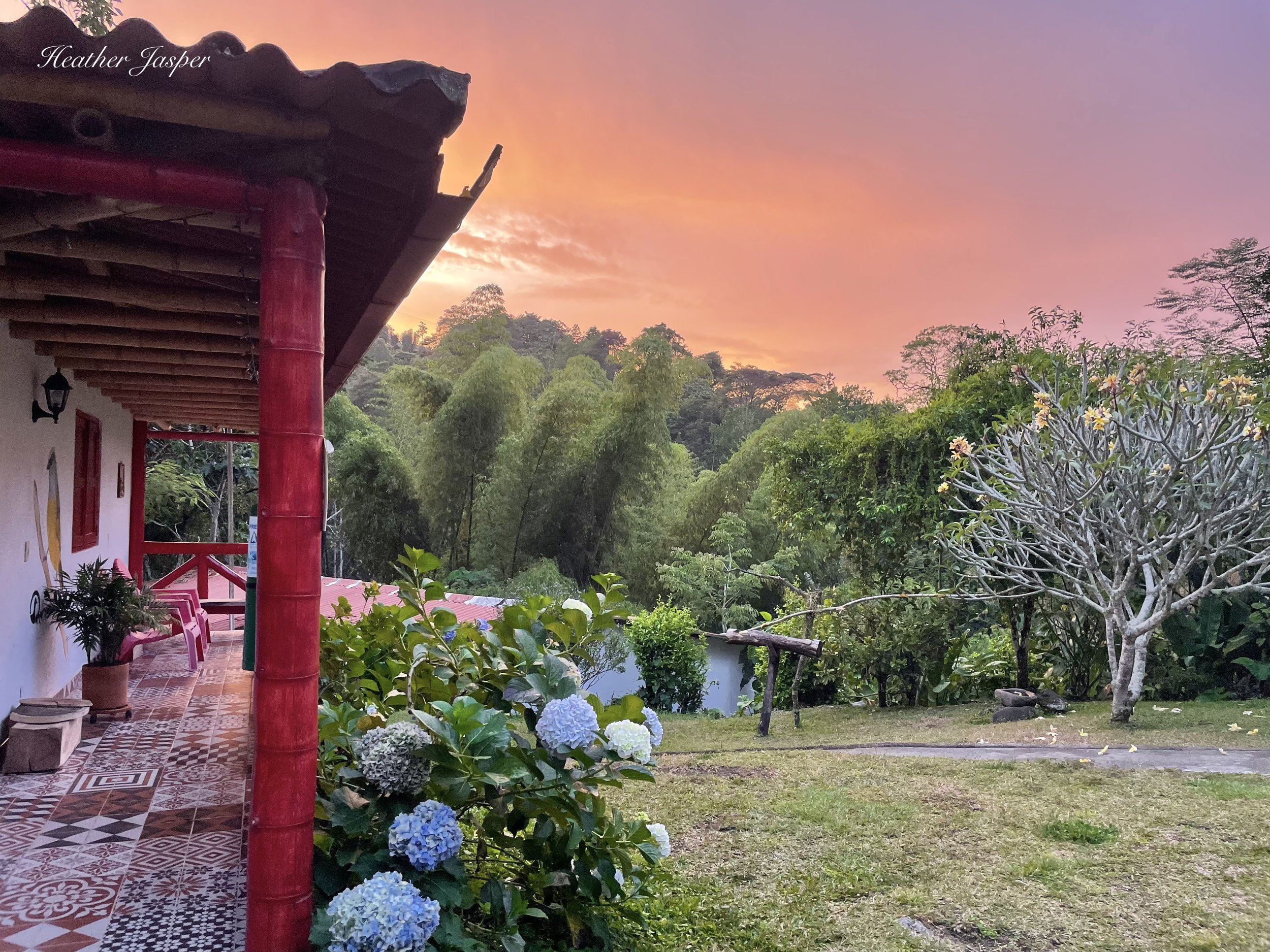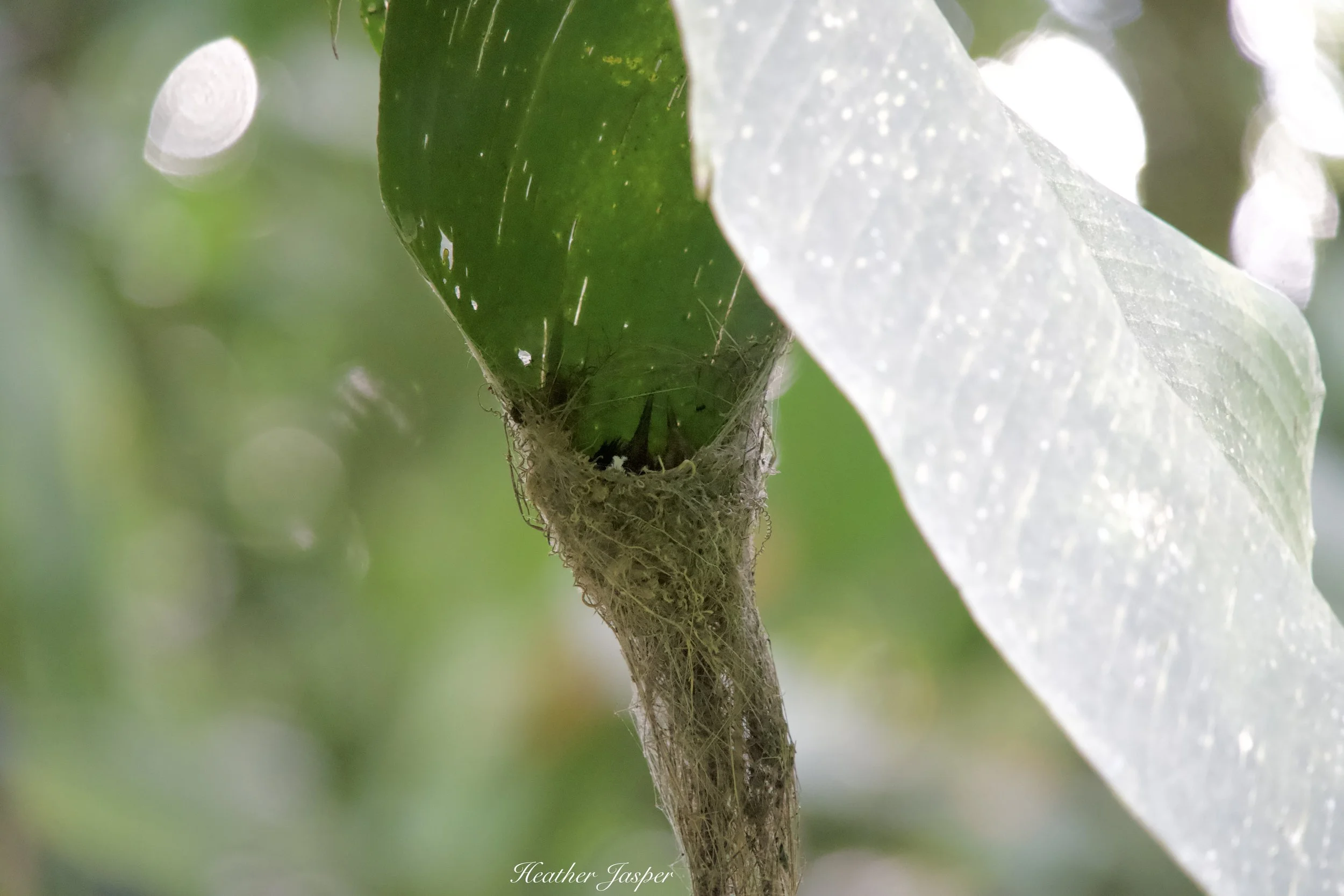Tinamu Birding
“Welcome to Tinamú! Would you like to sit down for some coffee or go birding first?”
From the moment you arrive at Tinamú Birding, there’s no doubt what this place specializes in or where you are. Claudia gave me a warm welcome, followed by an even warmer welcome from the kitchen staff who insisted on making me breakfast, though I’d already eaten.
Located in Colombia’s coffee region, called the Eje Cafetero, Tinamú Birding is located on land that used to be a coffee farm. In the early 1990s, the Londoño Jaramillo family decided to reforest their land and turn it into a haven for birds.
Even before I got a cup of coffee, I was presented with a pamphlet that lists all 270 species that have been registered on the property. It’s organized in the same order as the most popular Colombia bird book (Avifauna Colombiana) and has columns where you can check off which birds you’ve seen and which you’ve heard.
Andean Mot Mot
I could hear the mot mot throughout the day, though I only saw it a few times. Tinamú Birding has many beautiful birds like the mot mot that live on the property.
Colombia has an extravagant wealth of 1950+ bird species
Tinamú’s registered 270 species includes 20 species that are endemic to Colombia, or near endemic, meaning that they’re also sometimes found on the borders with Ecuador, Peru, Brazil, Venezuela, or Panama.
Colombia has hundreds of bird species that live in the equatorial region, but it also has hundreds more that migrate north from South America May-September and south from Central or North America September-April. You might be surprised to see a Baltimore Oriole or a Canada Warbler. You might also see an Azure Gallinule, which migrates up from Argentina.
Blue-gray Tanager
There are 13 species of tanagers that have been registered at Tinamú Birding. I saw Blue-gray tanagers from dawn to dusk because two pairs were nesting near my cabin.
Birding trails
With a list of 270 bird species, you’d expect this to be a large nature reserve, but in fact it’s only 12 hectares and all the trails together are less than 4km. That means the birds are so concentrated in a small area that you won’t waste any time walking through the forest looking for birds. At Tinamú, you walk through the forest looking at birds, everywhere, all the time.
Just sitting in front of my cabin I consistently saw several species of tanagers, chachalacas, woodpeckers, hummingbirds, woodcreepers, parrots, euphonias, flycatchers and more.
Misty mountains
One of my favorite things about the mountains in Colombia is that it’s not as hot as at sea level. The region is perfectly suited for coffee because there is frequent cloud cover and rain. Many coffee farms have shade trees to keep the sun from burning the coffee trees, but some farms just rely on clouds that sometime settle like fog over the region.
Back when Tinamú was a coffee farm, it had many shade trees. Those were the beginnings of the reforestation project that was completed in the 90s. Today, you’ll see a few coffee trees that have survived the forest regenerating around them. Mostly, the trails lead you through groves of native trees that attract hundreds of birds.
Birds frequently fly through the dining room at Tinamú and bird feeders on both sides provide constant entertainment.
Forget Colombia’s reputation from the 80s and 90s
The area around Tinamú Birding is so safe that the kitchen doesn’t have any walls. The refrigerators, appliances and everything in the kitchen is open to the forest on all four sides. The office, with the computer and lots of souvenirs in the gift shop, doesn’t have a door. This presents a problem because birds sometimes fly through the open doorway and then try to exit through the glass window for a while before finding the doorway again.
There are plenty of security cameras around the property, but the most exciting thing they usually record are agoutis stealing avocados straight from the trees.
Tinamú’s kitchen
There is almost always somebody in the kitchen, keeping the coffee fresh or preparing the next meal.
Tinamú Birding souvenirs
The office has a small souvenir and gift shop, where you can take home some of the amazing coffee that’s grown nearby.
Spacious cabins
Tinamú Birding has six spacious cabins, built to keep cool in the equatorial heat. Some of the cabins are duplexes and some are individual. I got to tour the cabins that weren’t occupied, and my favorites were the ones downhill from the kitchen because they felt more secluded in the forest. All the cabins have comfortable beds, large bathrooms, and mosquito nets on the bamboo window shutters. The cabins have safes for valuables and locks on the doors, though due to the security I wrote about above, I never used mine.
Steely-vented hummingbird nest
The guides at Tinamú know the best places and times to see birds, and also keep track of where they’re nesting. Can you see the two tiny beaks sticking up in the nest?
Banana delivery
Bird feeders throughout the property are constantly refilled with bananas, which requires a lot of bananas.
Colombian & international cuisine
Meals are eaten at large tables next to the kitchen, in a roofed area that’s open on three sides. The one wall has self-serve coffee all day, which was so good I didn’t need sugar or milk. It was balanced, delicious coffee. The food was delicious too and in my three days there each meal included traditional Colombian cuisine like arepas and international staples like stir fry with rice. I asked for vegetarian options at each meal and was always impressed.
If you’re considering a birding trip to Colombia, call Tinamú first.
Fernando Galdiz
Fernando can identify all 270 birds at Tinamú by sight, most by sound and knows the Latin names for all of them. He prefers to use the Latin names because people come from around the world to Tinamú and he says it’s best to have one common language.
Here are the birds I identified during my time at Tinamú Birding.
Little Tinamou, Colombian Chachalaca (endemic), Pale-vented Pigeon, Ruddy Ground-dove (endemic), Gray-headed Dove, Eared Dove (endemic), Common Potoo, Stripe-throated Hermit, Green Hermit (and nest with two babies), White-vented Plumeleteer, Steely-vented Hummingbird (near endemic), Rufous-tailed Hummingbird, Roadside Hawk, Spectacled Owl, Andean Motmot, Mustached Puffbird, Red-crowned Woodpecker, Lineated Woodpecker, Yellow-headed Caracara, Blue-headed Parrot, Spectacled Parrotlet (near endemic), Bar-crested Antshrike (near endemic), Checker-throated Stipplethroat Antwren, Jet Antbird, Blue-lored Antbird, White-crowned Tapaculo, Plain-brown Woodcreeper, Cocoa Woodcreeper, Streak-headed Woodcreeper, Golden-collared Manakin, Slaty-capped Flycatcher, Acadian Flycatcher, Great Kiskadee, Rusty-margined Flycatcher, Tropical Kingbird, Black-chested Jay (near endemic), House Wren, Speckle-breasted Wren, Swainson’s Thrush, Cocoa Thrush, Black-billed Thrush, Thick-billed Euphonia, Yellow-backed Oriole, Black-and-white Warbler, Bay-breasted Warbler, Golden-crowned Warbler, Canada Warbler, Summer Tanager, Flame-rumped Tanager, Crimson-backed Tanager (near endemic), Blue-gray Tanager, Palm Tanager, Scrub Tanager (near endemic), Blue-necked Tanager, Bay-headed Tanager, Saffron Finch, Streaked Saltator.
There’s more than birds!
I also saw several agoutis, one with a baby and one carrying an avocado it had just picked. There were iguanas lounging in the trees and I saw a false coral snake (non-venomous) one night when I was out looking for the Spectacled Owl. I just missed seeing a kinkajou family, who appeared a couple days after I left.




































